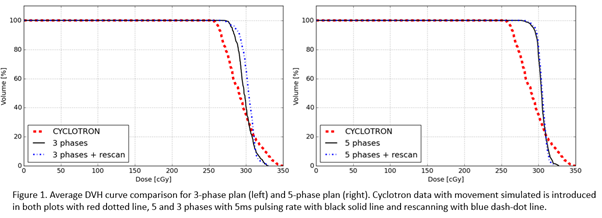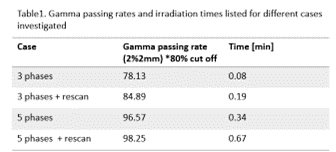3D Rescanning with motion synchronization for lung targets using a proton linac system.
Wioletta Kozłowska,
Switzerland
PO-1973
Abstract
3D Rescanning with motion synchronization for lung targets using a proton linac system.
Authors: Noora-Mari Pienimaki1,2, Wioletta Kozłowska1,2, Janine Bossé2, Katie O'Shea1,2, Jonathan B. Farr1,2
1Applications of Detectors and Accelerators to Medicine SA, Clinical Office, Meyrin, Switzerland; 2Advanced Oncotherapy plc, Clinical Office, London, United Kingdom
Show Affiliations
Hide Affiliations
Purpose or Objective
Various methods are considered to mitigate target position uncertainty caused by breathing motion. One method aims to synchronise dose delivery with target motion through use of Four-dimensional CT (4DCT)-derived subplans, created and delivered for selected phases of the breathing cycle [1]. Another method, rescanning, is well-established for improving the treatment uniformity for moving targets [2,3]. The aim of this study is to determine the effect of rescanning in spot delivery, combined with the subplan motion management method using scans, using the fast-pulsing beam model of the LIGHT (Advanced Oncotherapy plc, London, UK) Proton Therapy System (PTS).
Material and Methods
Three and five phases from 4DCT scans were selected to create three and five subplans, respectively, for lung targets. The treatment planning was performed using a commercial Treatment Planning System (TPS), RayStation 10B (RaySearch Laboratories AB, Sweden), and movement simulation was performed using an in-house algorithm, scripted in Python, to simulate the effect of spot movement during active scanning on the continuously moving target. The algorithm uses spot map information (such as spot weight, energy, and x-y coordinates for spot locations) exported from the TPS. For rescanning purposes, each spot was split, with half of the original spot weight for each. The breathing cycle was assumed to follow a Lujan2 trajectory [4], with a cycle length of 4 s, and the amplitude of 8.2 mm was defined from the target motion in the 4DCT set.
Results
The results obtained using the gamma passing rates [5] (Table 1) and average DVH curves (Figure 2) indicate that the treatment quality is improved with introduction of rescanning combined with the subplan method, compared to the use of the subplan method alone. The introduction of 3D rescanning improved the 3-phase plan gamma passing rate by 6.8% and the 5phase plan by 1.7%, respectively.

Introducing more phases and rescanning significantly increases the delivery time of treatment with cyclotrons due to their slower energy change time [1]. The LIGHT system, with its superior timing characteristic of delivering successive spots within 5 ms, including the energy switch, can mitigate this problem significantly.

Conclusion
Rescanning with the subplan method reduces the number of subplan phases required for motion mitigation. Furthermore, rescanning was more effective at improving treatment quality for the 3-phase plan than for the 5-phase plan. Therefore, the combination of a reduced phase-number plan with 3D rescanning can be an attractive option for high quality, fast irradiations of moving targets, especially considering the rapid 3D rescanning provided by the proton linac system.
References
1. Lis M, et al. 2021. Front Oncol. 11:712126.
2. Engwall E, et al. 2018. Phys Med Biol. 63(9):095006.
3. Ribeiro CO, et al. 2020. Phys Med Biol. 65:23NT01.
4. Lujan AE et al., 1999. Med Phys. 26:715-20.
5. Low, et al. 1998. Med Phys. 25:656-61.